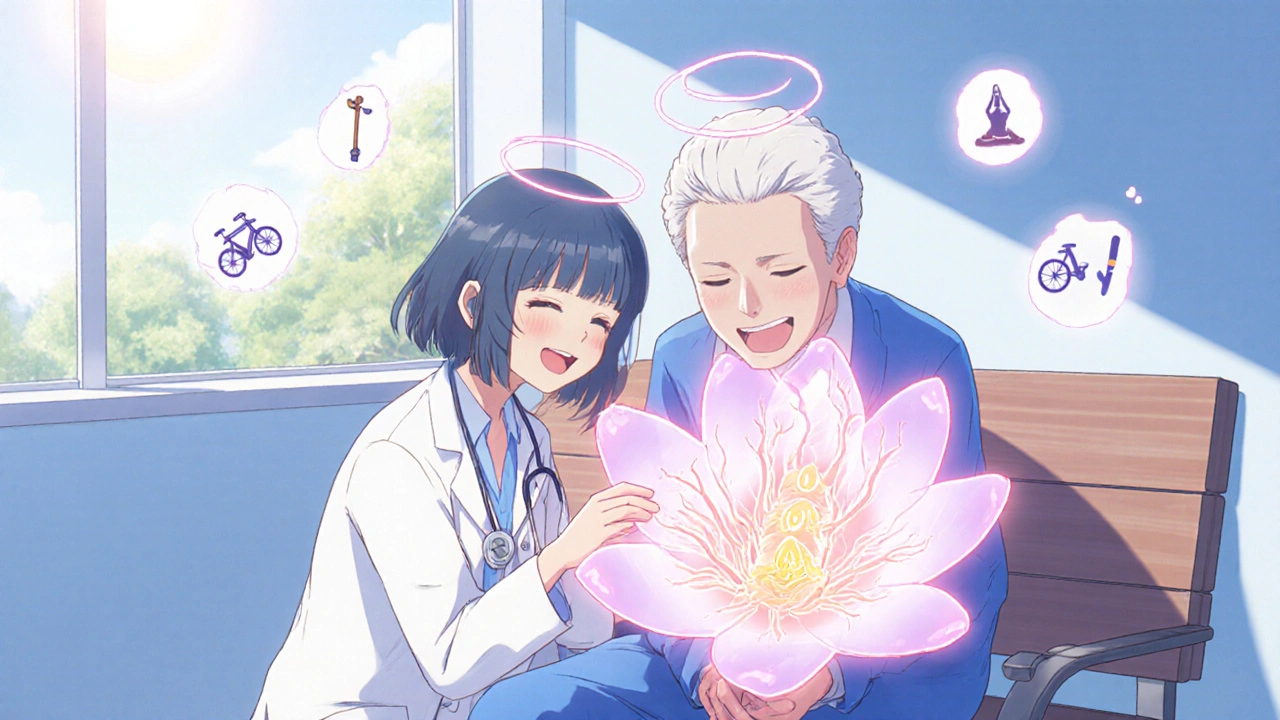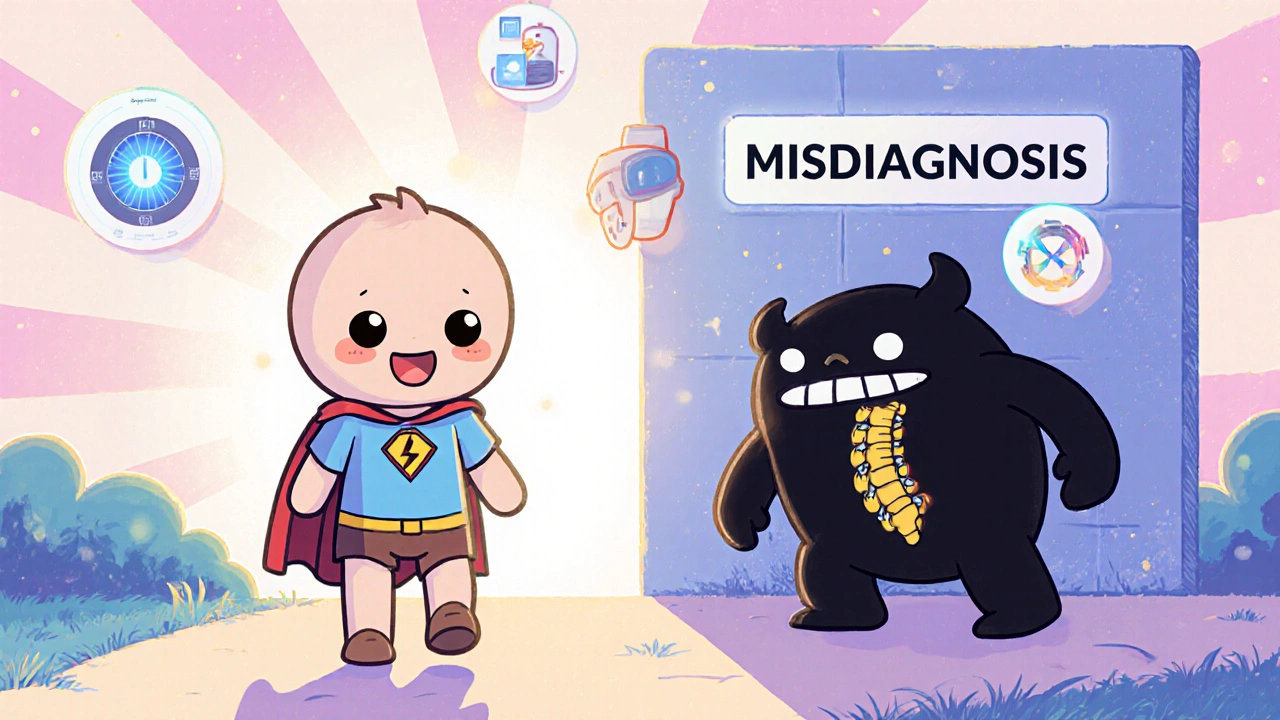Walking down the grocery store aisle should be simple. But for many people over 50, it becomes a challenge-not because of tired legs, but because their legs feel like they’re filled with lead. They have to stop, lean on the shopping cart, and wait for the pain to fade. This isn’t just aging. It’s neurogenic claudication, the most common symptom of lumbar spinal stenosis. And if you’ve been told it’s just “poor circulation,” you might be missing the real problem.
What Exactly Is Neurogenic Claudication?
Neurogenic claudication isn’t a disease on its own. It’s a warning sign. It happens when the spinal canal in your lower back narrows enough to press on the nerves that run down to your legs. This compression cuts off the normal flow of signals and blood to the nerves, causing pain, numbness, or weakness that shows up when you’re upright and moving. The classic pattern? You walk a few blocks, your legs start to ache, tingle, or feel heavy. You stop, sit down, or bend forward-and within seconds, the pain disappears. That’s the key. Unlike vascular claudication (which comes from poor blood flow), this pain doesn’t go away just by resting. It needs forward bending. That’s why patients often describe the “shopping cart sign”-leaning over a cart, walker, or even a kitchen counter gives instant relief. It’s not sudden. It creeps in. You might notice you can’t walk as far as you used to. You avoid stairs. You sit more during church or family events. Some people even switch to riding a bike because the bent-over position feels better. These aren’t quirks. They’re your body’s way of telling you something’s wrong in your spine.Differentiating Neurogenic from Vascular Claudication
This is where misdiagnosis happens-and it’s dangerous. Many doctors first think “poor circulation” when someone has leg pain with walking. But vascular claudication comes from blocked arteries. The pain is crampy, often in the calves, and goes away after a few minutes of rest, no matter how you sit or stand. Your pulses are weak. Your skin might be cool or pale. Neurogenic claudication is different. Your pulses are normal. Your feet feel warm. The pain is deeper, often in the buttocks or thighs, and it’s tied to posture. Bend forward? Relief. Stand tall? Pain returns. A negative straight leg raise test and normal foot pulses are big clues. And here’s a practical tip: if you can walk 200 feet before pain hits, but pushing a cart lets you walk the whole store, you’re likely dealing with spinal stenosis. One study found that 68-85% of people with confirmed lumbar stenosis use this “shopping cart” trick. Yet, many patients go years without the right diagnosis. One patient on Healthgrades said it took three doctors before someone asked: “Do you feel better when you lean forward?” That question changed everything.How Is It Diagnosed?
There’s no single test that confirms neurogenic claudication. Diagnosis is built on clues. Your doctor will start with a detailed history. They’ll ask:- Do you get leg or buttock pain when walking or standing?
- Does bending forward or sitting help?
- Do you use a cart or walker to relieve symptoms?
- Do you feel weakness or numbness in your legs while walking?

First-Line Treatment: Conservative Care
Most people don’t need surgery right away. In fact, 82% of early-stage patients see improvement with conservative care, according to clinical surveys. The goal isn’t to cure the narrowing-it’s to manage symptoms and keep you moving. Physical therapy is the cornerstone. Therapists teach you exercises that promote spinal flexion-like pelvic tilts, knee-to-chest stretches, and seated forward bends. They also train you to maintain a slightly bent posture during daily tasks. You’ll learn how to use your core muscles to reduce pressure on the nerves. Most patients need 6 to 8 weeks of consistent therapy to see real progress. Pain management often includes over-the-counter NSAIDs like ibuprofen or naproxen. For more persistent pain, doctors may prescribe low-dose nerve pain medications like gabapentin or pregabalin. These don’t fix the narrowing, but they can reduce the burning or tingling sensations. Activity modification matters too. Avoid prolonged standing. Use a cane or walker to stay bent forward when walking. Ride a stationary bike instead of walking if it feels better. These aren’t hacks-they’re proven strategies. One study showed that 78% of patients who understood and used forward-flexion techniques could walk farther without pain.When Conservative Care Isn’t Enough
If symptoms persist after 3-6 months of consistent conservative treatment, it’s time to consider other options. Epidural steroid injections are the next step. These shots deliver anti-inflammatory medicine directly around the compressed nerves. Success rates vary, but studies show 50-70% of patients get temporary relief lasting weeks to months. It’s not a cure, but it can buy time and reduce pain enough to resume physical therapy. If pain and weakness continue to worsen-especially if you’re losing muscle strength, having trouble with balance, or losing control of your bladder or bowels-surgery becomes a serious option. The goal is to take pressure off the nerves. Common procedures include:- Laminectomy: Removing part of the bony arch of the vertebra to open up the spinal canal.
- Laminotomy: A smaller, targeted removal of bone to relieve pressure on one nerve.
- Minimally invasive decompression: Using small incisions and specialized tools to remove bone or tissue with less muscle damage.
- Interspinous process decompression (e.g., Superion device): A newer option approved by the FDA in 2023 that acts like a spacer to keep the spine slightly flexed, relieving pressure without major surgery.

What Patients Say About Their Journey
On patient forums, common themes emerge. One Reddit user wrote: “I could only walk 200 feet before my legs turned to concrete. But push a cart? I walked the whole store.” Another said: “I thought I had bad circulation. Turns out, my spine was pinching the nerves. No one asked about bending forward until my fifth doctor.” The emotional toll is real. People feel like they’re losing their independence. They stop going out. They feel guilty for slowing down family walks. But once they get the right diagnosis and a plan, many say their quality of life improves dramatically. The key isn’t just treatment-it’s understanding.What’s Changing in Treatment?
The field is shifting. In 2023, the American Academy of Orthopaedic Surgeons updated its guidelines to make structured exercise the first-line recommendation, not just an option. That’s a big deal-it means doctors are finally recognizing movement as medicine. New devices like the Superion implant are giving patients less invasive options. Clinical trials showed 78% satisfaction at two years. Meanwhile, researchers are working on better diagnostic tools. The International Spine Study Group is finalizing a standardized algorithm to help doctors match symptoms with imaging findings more accurately. That could cut down misdiagnoses dramatically. Costs vary. Conservative care runs $500-$2,000 a year. Surgery? Between $15,000 and $50,000. Insurance usually covers it, but out-of-pocket costs depend on your plan and provider.When to Seek Help
If you’re over 50 and notice:- Leg pain or heaviness that comes with walking or standing
- Relief when you sit or bend forward
- Weakness or numbness in your legs that doesn’t go away with rest
- Difficulty walking farther than you used to
Is neurogenic claudication the same as peripheral artery disease?
No. Neurogenic claudication is caused by nerve compression in the spine, while peripheral artery disease (PAD) is caused by blocked arteries reducing blood flow to the legs. The pain from PAD feels like cramping and goes away with rest, no matter your posture. Neurogenic claudication pain improves only when you bend forward or sit. Your pulses are normal in neurogenic claudication but weak or absent in PAD.
Can spinal stenosis get worse over time?
Yes. Spinal stenosis is often progressive due to ongoing degeneration of discs, joints, and ligaments in the spine. Symptoms may slowly worsen over months or years. That’s why early diagnosis and conservative management are important-to slow progression and maintain mobility as long as possible.
Do I need an MRI to diagnose neurogenic claudication?
Not always. Diagnosis is primarily based on symptoms and physical exam. An MRI is used to confirm spinal narrowing and rule out other causes, but many people have stenosis on MRI without symptoms. A clear clinical picture-especially the posture-related pain pattern-is more important than imaging alone.
Can exercise make neurogenic claudication worse?
Only if it involves spine extension or prolonged standing. Walking upright on flat ground might trigger pain, but flexion-based exercises like cycling, swimming, or seated stretches are safe and helpful. Physical therapists design programs that avoid positions that compress the nerves and focus on movements that open the spinal canal.
Is surgery the only permanent solution for neurogenic claudication?
Surgery is the only way to physically widen the spinal canal and relieve pressure on the nerves. But it’s not always necessary. Many people manage symptoms effectively for years with physical therapy, posture changes, and pain management. Surgery is recommended only when conservative care fails and symptoms significantly limit daily life.

 Nov, 16 2025
Nov, 16 2025

mike tallent
November 17, 2025 AT 12:23Been there. Thought I had PAD until my PT asked if I leaned on the cart. 😅 Turns out, my spine was doing the Macarena with my nerves. Physical therapy saved my walks. Now I bike, stretch, and laugh at people who say 'just walk more.' 💪🦵
Julie Roe
November 18, 2025 AT 03:09I’ve seen so many older patients feel guilty for slowing down, like it’s a personal failure. But this? This isn’t laziness. It’s your body screaming for help in a language most doctors ignore. The shopping cart sign is real, and it’s not a quirk-it’s a diagnostic goldmine. If your doc doesn’t ask about bending forward, find a new one. You deserve better than 'it’s just aging.'
vinod mali
November 19, 2025 AT 13:35in india we call this 'back ka dard' but no one connects it to walking. everyone thinks it's arthritis or bad posture. i saw my uncle suffer for 4 years till he found a physio who knew about flexion. now he rides his scooter like a boss. 🛵
Peter Stephen .O
November 20, 2025 AT 22:34OMG YES. I used to think I was just out of shape. Then I realized I could walk 3 blocks standing straight… but 10 blocks leaning on a walker? Total game changer. I started biking, did daily pelvic tilts, and now I hike with my grandkids. No surgery, no meds. Just movement that doesn’t crush your nerves. 🙌
Rob Goldstein
November 21, 2025 AT 12:44Neurogenic claudication is often misdiagnosed because clinicians default to vascular causes without assessing posture-dependent symptomatology. The key differentiator is the flexion bias-this is neurologic, not ischemic. MRI findings without clinical correlation are misleading; up to 67% of asymptomatic elderly show stenosis. Always correlate with history and physical exam. PT with flexion-based protocols is first-line. Epidural steroids can be bridging therapy. Surgery is definitive but only after multimodal conservative failure.
Jennifer Howard
November 23, 2025 AT 06:01It is absolutely unforgivable that medical professionals continue to misattribute this condition to peripheral artery disease. The lack of basic neurological assessment in geriatric populations is a national disgrace. One would think that after decades of peer-reviewed literature, the 'shopping cart sign' would be taught in every medical school. Instead, patients are prescribed statins and told to 'walk it off.' This is malpractice disguised as medicine.
Andrew Cairney
November 23, 2025 AT 22:22Wait… so you’re telling me the government doesn’t want us to know about this? 🤔 Why do all the 'new' treatments like Superion only come out after big pharma gets involved? And why are the studies always funded by device companies? I’ve seen 3 guys who had surgery… all got worse. Coincidence? I think not. They’re pushing this to sell implants. Stay off the table. Do the stretches. And don’t trust any 'FDA approved' gadget that costs $20k.
jalyssa chea
November 25, 2025 AT 14:21so like… you mean to tell me bending over helps? wow. i thought i was just getting fat. my doctor said i need a knee replacement. i guess i should’ve asked if my spine was pinching my nerves. duh. also i think my cat has spinal stenosis. she only walks when she’s napping on my lap. 🐱
Sylvia Clarke
November 25, 2025 AT 23:00Let’s be honest-this isn’t just about medicine. It’s about how we treat older people. We tell them to 'slow down' like it’s a personal choice. But when their body says 'I can’t,' we call it 'aging.' Meanwhile, a 70-year-old who leans on a cart to walk the grocery aisle is doing more to preserve their independence than half the doctors who’ve dismissed them. The real breakthrough isn’t the Superion device-it’s the moment someone finally asks, 'Do you feel better when you bend forward?' That’s compassion. That’s care. And it’s long overdue.
Joyce Genon
November 26, 2025 AT 04:01Look, I read the whole thing. And honestly? It’s all just a fancy rebranding of 'your spine is crumbling.' You say 'conservative care works for 82%'-but that’s not the same as 'it fixes anything.' You’re just teaching people to live with pain. And the surgery stats? 70-80% improvement? That means 1 in 4 people get no benefit or get worse. And who pays for the follow-up PT if insurance drops coverage? You think the system cares? Nah. They just want you to sign the consent form and get out of the hospital before lunch. This isn’t a guide-it’s a sales pitch with footnotes.
John Wayne
November 26, 2025 AT 15:47Interesting. But let’s not pretend this is some groundbreaking revelation. The 'shopping cart sign' has been documented since the 1970s. The fact that it’s still being treated as novel suggests a systemic failure in medical education. And the mention of 'new' FDA-approved devices? A distraction. The real solution is simple: stop letting insurance dictate treatment protocols. Let patients choose. But of course, that would require accountability. And we all know how that ends.
Gary Lam
November 27, 2025 AT 12:34Bro, I’m from the Philippines and we have this thing called 'bukal sa likod'-back pain that kills your walk. My lola used to lean on the bamboo pole while washing clothes. No MRI, no PT, just instinct. She lived to 92. Sometimes the body knows what to do before the doctors figure it out. Bend forward. Walk slow. Don’t fight it. And if you can ride a bike? Do it. Life’s too short to stand tall when your spine says sit.
Jennie Zhu
November 27, 2025 AT 14:21While the clinical presentation of neurogenic claudication is well-documented, the current diagnostic algorithm remains insufficiently standardized across primary care and specialty settings. The absence of a validated symptom severity index, coupled with the high prevalence of asymptomatic radiographic stenosis, necessitates a paradigm shift toward phenotypic stratification. Furthermore, the economic burden of surgical intervention, while clinically justified in select cohorts, is not equitably distributed within the U.S. healthcare system, thereby exacerbating disparities in access to definitive care.
Abdul Mubeen
November 27, 2025 AT 22:11Who benefits from this narrative? The hospitals? The device manufacturers? The physical therapy chains? There’s no mention of the pharmaceutical industry’s role in promoting gabapentin as a first-line fix-despite its side effects and lack of long-term efficacy. And why are there no warnings about the psychological manipulation of patients into believing they 'must' undergo surgery? This feels like a carefully curated PR campaign disguised as medical advice. Don’t be fooled. Your spine is not broken. The system is.